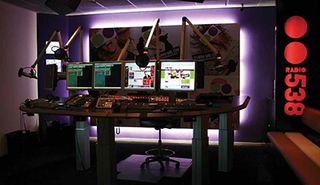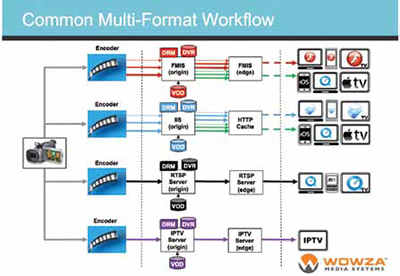Streaming video is redefining media consumption. Proprietary, single-format media delivery systems have gone the way of the dinosaurs, as today’s viewers prefer to access content anywhere, anytime, and on the device of their choice. But in an environment flooded with different formats, protocols, and devices, how can content producers reach the largest potential audience with the least amount of infrastructure at the lowest possible cost?
We know that consumers are receiving streamed content on their smartphones, laptops, and living room televisions. But today’s multiscreen users are also switching between devices mid-stream. For content producers, this raises the stakes in providing seamless, high-quality streaming experiences to users who might start watching a professional baseball game on a Microsoft Surface tablet during their bus ride home, stream the second half off a Roku box connected to their HDTV, and later replay the highlights from an Apple iPad at a coffee shop. To complicate things, most device families have their own streaming format (e.g., HLS for Apple iOS devices, Smooth Streaming for Windows phones, RTSP for BlackBerry, etc.), and each device can support different levels of audio and video quality. But there’s no need to panic. Below is an easy one-stop-shopping setup that will stream from a single encoder to any type of device with very little investment.
The Source

A subsidiary of RTL Group, Europe’s largest TV, radio, and production company, Radio538 turned to Wowza to help bring
in a larger audience by delivering content to Flash and Silverlight players, iPhones and iPads, Android and other smartphones. Wowza Media Server 3.5 is now available offering new features and enhancements. Current Wowza Media Server version 2 and 3 customers can upgrade for free at www.wowza.com/tradeup. The first necessary component is a source device to capture the event. Content from the source device becomes the stream feed, either used for live streaming or stored for on-demand video that users will watch at a later time. There are two main choices for source devices: HD video cameras or IP cameras. The advantage of high-def cameras is superior production quality, notably the ability to move nimbly within a location and quickly pan across events. IP cameras are better suited for static recording situations that require little or no movement. Examples include surveillance cams and recording fixed views of an entire tennis court. Some IP cameras will also automatically encode content, which could present cost advantages later in the workflow.
Encoding
The stream is then sent to an encoder. Encoders are hardware or software-based devices that convert audio and video data from one format or signal to another. Raw audio and video captured from cameras are rarely compatible with streaming platforms and user devices. Encoders also compress larger files for more efficient handling later in the process. There are many encoders available, from free or low-cost software-based options to higher-priced options. Less expensive encoders sometimes provide fewer encoding options, with the goal of limiting user errors. More expensive encoders, including many hardware-based encoding appliances, can be more complex but offer more dexterity when it comes to options and performance.
Media Servers
This is where the magic happens. As the stream travels into the media server, functionalities such as transcoding and transrating, network digital video recorder (nDVR), and adaptive bitrate (ABR) streaming are made available to maximize the stream’s quality, the number of devices to which it can deliver, and the user experience. But alas, not all media servers are created equal. The most critical difference is the number of streaming protocols they support. For instance, Windows Media Server will only support traditional streaming using proprietary Windows Media unicast and multicast, while RealNetworks Helix Server will not support Adobe HDS or Microsoft Smooth Streaming. Traditionally, this problem meant that a significant investment in multiple encoders and media servers was required to ensure delivery to a high number of streaming protocols and devices. The obvious disadvantages of this convoluted setup included cost, complexity, and infrastructure maintenance.
Thankfully, a new generation of media servers has simplified the process. These new solutions offer a better approach with a unified media infrastructure supporting what is also known as “unified workflow streaming.” The model is based on a unified media server, a single server software type that enables streaming from a common set of encoded on-demand or live assets simultaneously to any supported player device over any protocol. A unified media server eliminates the need for client-specific encoders and, because it can be deployed or redeployed on commodity server hardware, it can take quick advantage of evolving performance increases. Unified media server software also makes it possible to achieve in excess of 10 Gbps per-server streaming performance using off-the-shelf hardware.
Conclusion
In a dynamic and yet unpredictable young market, shared any-screen infrastructure protects investment because it delivers the goods no matter what media platform, technology, or device is trending. Likewise, it enables the user to react nimbly to marketplace and technology changes. Unified media server infrastructure is also associated with significant cost savings because it lowers the initial equipment investment as well as associated maintenance and operation. In all, the unified streaming solution is affordable enough that even a small organization can use it to take advantage of the opportunities in streaming media.
Using a unified media infrastructure, content producers are empowered with a more flexible, powerful, and costeffective streaming workflow to deliver TV-like experiences to users anytime, anywhere, and on the device of their choice.
Chris Knowlton is vice president of product management for Wowza Media Systems.
info
Wowza Media Systems
wowza.com











